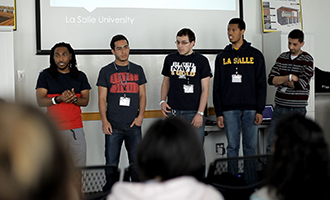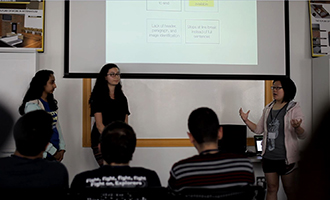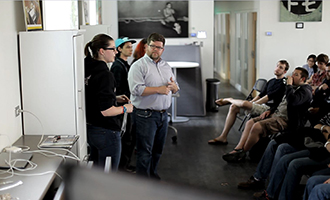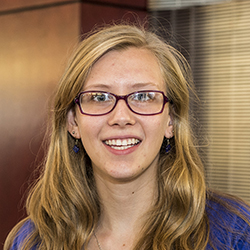Hacks at evoHaX that changed lives
Last weekend, a portable voice recognition device augmented with bluetooth that converts speech to text to desktop and web commands won the first place at evoHaX, a three day Hackathon with a focus on web accessibility. This device was built by a team of five women from Drexel University's Society of Women Engineers, who were competing against student developers from La Salle University, Saint Joseph's University, Swarthmore College, and West Chester University.
evoHaX, organized by EvoXLabs in partnership with Philadelphia Link, differed from a typical Hackathon as five teams comprising of young developers and representing five universities in Philadelphia were paired randomly with a subject matter expert - an individual with a disability that poses limitations while accessing information on the Web. Projects targeted solutions for people with vision and hearing impairments, as well as for people with cognitive disabilities.
The event kicked off Friday night with a reception featuring five speakers from the tech community who discussed accessible technology and design. The speakers included Anat Caspi, a leader in biotechnology, Front-end web developer and Girl Develop It Philly coordinator, LeeAnn Kinney, Marco Maertens, Director of Technology at Digitas Health LifeBrands, Associate professor of Computer Science Richard Burns, from West Chester University, and Deborah Dahl, Principal, Conversational Technologies.
The Hacking kicked off Saturday morning with the teams conversing with their respective experts about the difficulties they face while accessing information on the Web, followed by designing a viable solution. Eli St. Amour, Walei Sabry and Neil McDevitt participated as the subject matter experts. The teams worked until 11 pm Saturday, and then returned on Sunday morning at 10 to put finishing touches on their projects until the "Stop Coding" call at 2:45 that afternoon.
Each team was given ten minutes to present their solution. Angel Rivera, a Developer Evangelist at Point.io, Austin Seraphin, an iOS developer and accessibility consultant who has been blind since birth, and Howard Bilofsky, an international leader in informatics for Life Science Research, judged the solutions on the basis of originality, creativity, usefulness, practicality, and scalability.
Here are the solutions developed at evoHaX:

Jumpkey
West Chester University was the first to present their system of universal hot-keys to improve web navigation. Working via a browser extension, their system analyzes a website's content picking out common pages such as Home, About Us, and Login, by searching for keywords and phrases. These pages are then attached to the hot-keys, which can be used to expediently navigate a site, rather than tabbing through an entire page to search for the correct link.

iDescribe
La Salle University developed a website for crowdsourcing alt text, descriptions of an image which can be read by a screen reader. Their site collects images from web developers, which can be described by sighted users from all over the web. The descriptions are then pushed back to the site on which the image is located, making its contents accessible to a user browsing the site with a screen reader.

Augmented Speech-reader and Bluetooth Module
Drexel University's first place project was designed in response to the challenges accessing information on the web faced by someone with Alexia (the inability to recognize words). Their work on a portable voice recognition device augmented with Bluetooth converted speech to text as well as desktop and web commands. The team used Arduino to develop this solution that has the capability to control the Web through voice.

EyeContext
Saint Joseph's University was given an honorable mention as the runner-up team. Their project was a web-browser extension that adds context clues to a website's text, in the form of related icons embedded next to words. The goal is to make identifying words and content easier for people who have disabilities like dyslexia or alexia, by providing additional context in order to help a user better understand what they are reading.

Video Caption Awareness Using Data Analysis
The team from Swarthmore College parsed data from Youtube to create a site containing an interactive graphic with information about the number of Youtube videos that are subtitled, and therefore accessible to the hearing impaired. (Of the 350,000 videos uploaded to Youtube on April 11, only 1.8 percent had subtitles.) Their site also included resources for adding how to add subtitles to videos on Youtube and additional information about accessible design for the hearing impaired.
Ather Sharif, who advocates for web accessibility, along with his team worked hard to make evoHaX a successful and impactful reality. Sharif declared, "Next year we're taking the event to the state level,". So be on the lookout for evoHaX 2016!
This event was hosted at Benjamin's Desk as part of the Philly Tech Week 2015, and was partially sponsored by AYC Media and Lyft.
Created: 29 April, 2015



Disqus Comments